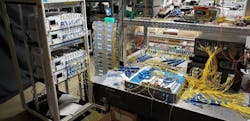With its state-of-the-art large-scale spatial optical switching, NICT's 1 Pbit/s network demonstration aims at petabit-class next-generation optical networks that use spatial-division multiplexing. The experimental network testbed used three types of multicore fibers and included practical requirements of real networks, such as protection switching. The system was demonstrated in four fundamental scenarios that constitute the building blocks of next-generation optical fiber networks:1. Optical switching of 1 Pbit/s of data2. Redundant configuration to support network failures or fiber breaks3. Branching of 1 Pbit/s signals into different types of optical fibers with various capacities4. Management of lower-capacity 10 Tbit/s signals within the 1 Pbit/s network NICT says that it will continue to pursue the advancement of ultrahigh-capacity telecommunications networks in collaboration with industry, academia, and government.Source: https://www.nict.go.jp/en/press/2019/10/17-1.html
Got optics- and photonics-related news to share with us? Contact John Wallace, Senior Editor, Laser Focus World
Get more like this delivered right to your inbox

John Wallace | Senior Technical Editor (1998-2022)
John Wallace was with Laser Focus World for nearly 25 years, retiring in late June 2022. He obtained a bachelor's degree in mechanical engineering and physics at Rutgers University and a master's in optical engineering at the University of Rochester. Before becoming an editor, John worked as an engineer at RCA, Exxon, Eastman Kodak, and GCA Corporation.

